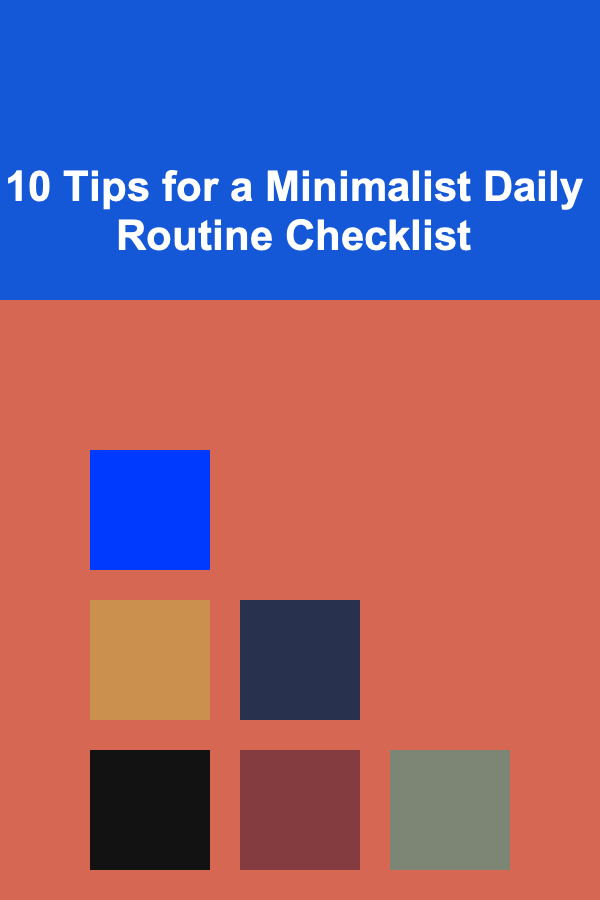
10 Tips for a Minimalist Daily Routine Checklist
ebook include PDF & Audio bundle (Micro Guide)
$12.99$5.99
Limited Time Offer! Order within the next:

In today's fast-paced world, many people are overwhelmed by the constant pressure of managing multiple tasks, projects, and commitments. This often leads to stress, burnout, and a lack of focus. One way to combat these challenges is by simplifying your daily routine. By embracing minimalism in your daily life, you can focus on what truly matters, improve your productivity, and cultivate a sense of calm.
In this article, we'll explore 10 tips for creating a minimalist daily routine checklist that will help you streamline your day, prioritize your well-being, and boost your productivity. These tips are designed to help you eliminate distractions, reduce decision fatigue, and focus on the essentials.
Start Your Day with a Morning Routine
The way you start your day sets the tone for the rest of it. A minimalist morning routine doesn't have to be long or complicated --- it's about setting yourself up for success with a few intentional actions.
Key Elements of a Minimalist Morning Routine:
- Wake up early: Waking up just 30 minutes earlier can make a big difference. It gives you quiet time to focus on yourself before the world gets busy.
- Hydrate: Drink a glass of water to rehydrate your body and refresh your mind.
- Practice mindfulness: Whether it's through meditation, deep breathing, or simply sitting in silence, take a moment to center yourself.
- Move your body: A short stretching routine or a few minutes of light exercise can increase your energy levels for the day.
A minimalist morning routine should be simple, achievable, and focused on nurturing your mind and body.
Prioritize Your Tasks with a Daily Top 3 List
One of the best ways to stay focused and organized is by narrowing down your tasks to the three most important ones. Instead of creating a long to-do list that feels overwhelming, a "Top 3" approach ensures you are tackling the things that matter most.
How to Create a Daily Top 3 List:
- Limit your focus: Choose the three tasks that will move you forward in the most meaningful way. These tasks should align with your goals and priorities.
- Be realistic: Don't overburden yourself. Make sure these tasks are achievable within the time and energy you have for the day.
- Break them down: If a task feels too big, break it down into smaller, manageable steps.
Focusing on a few essential tasks reduces distractions and helps you stay motivated throughout the day.
Eliminate Non-Essential Activities
Minimalism is all about simplifying and removing the unnecessary. Take a look at your daily routine and identify activities that don't contribute to your well-being or goals.
Tips for Eliminating Non-Essential Activities:
- Minimize screen time: Limit social media use, avoid unnecessary apps, and restrict digital distractions.
- Say no more often: Avoid over-committing to events or tasks that don't align with your values or priorities.
- Automate tasks: Use tools and systems to automate routine tasks (such as grocery shopping, bill payments, or email sorting) to free up time and energy for more important activities.
By eliminating non-essential activities, you create more space in your day for meaningful and fulfilling tasks.
Set Boundaries and Protect Your Time
One of the key elements of minimalism is recognizing the importance of time. Setting clear boundaries around how you spend your time ensures that you protect it and use it wisely.
How to Set Effective Boundaries:
- Establish work hours: Set a start and end time for your workday. Avoid checking emails or working outside of these hours to prevent burnout.
- Create designated spaces for tasks: Designate specific areas for work, relaxation, and hobbies to prevent distractions and maintain focus.
- Be mindful of your energy: Learn to recognize when you're feeling drained and take breaks accordingly. Protect your time by scheduling rest periods to recharge.
When you set boundaries, you prevent yourself from over-committing and help create a more balanced daily routine.
Embrace a "One Thing at a Time" Approach
In a world that constantly demands multitasking, it can be tempting to juggle several tasks at once. However, multitasking often leads to reduced efficiency and quality of work. A minimalist daily routine involves focusing on one thing at a time.
How to Implement "One Thing at a Time":
- Single-task: Instead of switching between tasks, devote your full attention to the task at hand until it is completed.
- Limit distractions: Turn off notifications, close unrelated tabs, and create a distraction-free environment to focus on your current task.
- Practice deep work: Schedule blocks of uninterrupted time for important tasks that require your full attention and focus.
By focusing on one thing at a time, you improve both the quality and speed of your work while reducing the stress that comes with multitasking.
Keep Your Environment Clutter-Free
A cluttered environment can negatively impact your mental clarity and productivity. Minimalism isn't just about simplifying your schedule --- it's also about simplifying your physical surroundings.
Tips for a Clutter-Free Environment:
- Declutter regularly: Regularly go through your possessions and get rid of items that no longer serve a purpose or bring you joy.
- Maintain clean spaces: A tidy workspace promotes focus and efficiency. Keep only the essentials on your desk or work area.
- Simplify your belongings: Opt for items that are functional, versatile, and have multiple uses.
By keeping your environment neat and simple, you create a calming atmosphere that fosters focus and creativity.
Establish a Consistent Sleep Schedule
Sleep is essential for maintaining your health and energy levels throughout the day. A minimalist daily routine includes prioritizing quality sleep by establishing a consistent sleep schedule.
How to Create a Sleep-Friendly Routine:
- Go to bed and wake up at the same time each day: Consistency helps regulate your body's internal clock, improving the quality of your sleep.
- Create a bedtime ritual: Wind down by reading, listening to calming music, or practicing relaxation techniques before bed.
- Limit caffeine and screen time: Avoid stimulants and digital devices at least an hour before bed to help your body prepare for sleep.
By prioritizing sleep, you ensure that you are rested and ready to take on the day's challenges.
Simplify Your Meals
Meal planning and preparation can be time-consuming and stressful, but a minimalist approach to meals can make this aspect of your routine more manageable.
Tips for Simplifying Meals:
- Plan simple meals: Choose recipes that require few ingredients and can be prepared quickly. Focus on nutrient-dense, easy-to-make meals.
- Meal prep in advance: Prepare meals or ingredients ahead of time so you can save time during the week.
- Minimize decision-making: Simplify your choices by sticking to a rotating menu or by limiting the number of meals you cook during the week.
Simplifying your meals allows you to spend less time on food preparation and more time on other important activities.
Incorporate Regular Movement
Physical activity is crucial for maintaining good health and mental clarity. A minimalist routine doesn't require hours of intense exercise --- short bursts of movement throughout the day can make a big difference.
How to Incorporate Movement:
- Take short walks: A 10-15 minute walk after meals or during breaks can help refresh your mind and improve circulation.
- Stretch regularly: Incorporate stretching into your routine to alleviate tension and improve flexibility.
- Opt for short, effective workouts: High-Intensity Interval Training (HIIT) or bodyweight exercises can provide a great workout in under 30 minutes.
Regular movement not only benefits your physical health but also enhances your productivity and mood.
Reflect and Adjust Your Routine
A minimalist daily routine is a work in progress. Regular reflection and adjustments are necessary to ensure that your routine remains aligned with your goals and priorities.
How to Reflect on Your Routine:
- Review your day: At the end of each day, take a few minutes to reflect on what went well and what could be improved.
- Adjust as needed: If you find certain tasks or habits aren't working, adjust your routine to fit your evolving needs.
- Be flexible: Life is unpredictable, so be open to tweaking your routine based on changing circumstances.
By regularly reflecting and adjusting your routine, you ensure that your minimalist approach continues to serve you well.
Final Thoughts
A minimalist daily routine checklist is not about doing less, but about doing more of what truly matters. By simplifying your tasks, eliminating distractions, and focusing on the essentials, you can create a routine that enhances your well-being, boosts productivity, and fosters a sense of calm. Minimalism in your daily routine isn't about perfection --- it's about finding balance and creating space for what's most important to you. Embrace these 10 tips, and you'll be well on your way to living a more intentional and fulfilling life.
Reading More From Our Other Websites
- [Star Gazing Tip 101] From Ground to Galaxy: How Drones Enhance Amateur Astronomy
- [Screen Printing Tip 101] Essential Screen Printing Equipment for Beginners: A Complete Starter Kit Guide
- [Personal Care Tips 101] How to Create a Sustainable Fitness Routine
- [Home Family Activity 101] How to Build a Family Movie Theater Experience at Home
- [Home Budget Decorating 101] How to Create a Cozy Atmosphere with Lighting
- [Organization Tip 101] Converting to LED Recessed Lighting: Cost and Energy Savings Explained
- [Organization Tip 101] Why Creating Zones in Your Home Enhances Flow
- [Whitewater Rafting Tip 101] Flow State on the River: How Rafting Amplifies Mindful Presence
- [Personal Care Tips 101] How to Choose the Right Blush Brush for Different Textures
- [Home Renovating 101] How to Use Digital Tools for Effective Renovation Project Management and Tracking

How to Keep Your Home Safe with Regular Electrical System Inspections
Read More
How to Make Your Home a Great Place for Multiple Pets
Read More
How to Plan for Financial Independence and Early Retirement
Read More
How to Set Up a Reunion Check-In Station for Smooth Arrivals
Read More
SEO Specialist Handbook: A Practical Approach to Search Engine Optimization
Read More
How to Translate Hand-Drawn Designs into Quilting Patterns
Read MoreOther Products

How to Keep Your Home Safe with Regular Electrical System Inspections
Read More
How to Make Your Home a Great Place for Multiple Pets
Read More
How to Plan for Financial Independence and Early Retirement
Read More
How to Set Up a Reunion Check-In Station for Smooth Arrivals
Read More
SEO Specialist Handbook: A Practical Approach to Search Engine Optimization
Read More